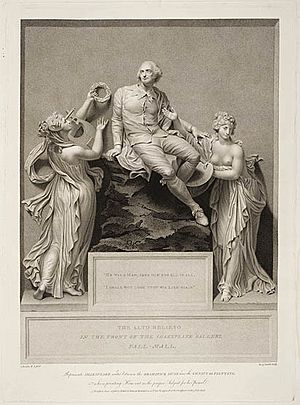Thomas Banks (sculptor) facts for kids
Quick facts for kids
Thomas Banks
|
|
|---|---|

Engraved portrait of Banks by William Daniell (1809)
|
|
| Born | 29 December 1735 London, England
|
| Died | 2 February 1805 (aged 69) London, England
|
| Known for | Sculpture |
Thomas Banks (29 December 1735 – 2 February 1805) was a very important English sculptor from the 1700s. He created many famous statues and monuments that you can still see today.
Contents
Life of Thomas Banks
Thomas Banks was born in London. His father, William Banks, worked as a surveyor and managed land for the Duke of Beaufort. Thomas went to school in Ross-on-Wye.
His father taught him how to draw. From 1750 to 1756, Thomas learned to be a woodcarver in London. This is called an apprenticeship. In his free time, he worked on sculptures. He spent his evenings in the studio of Peter Scheemakers, a sculptor from Flanders. During this time, he also worked for the architect William Kent.
Before 1772, Thomas Banks had already shown many great artworks. That year, he won a special scholarship from the Royal Academy. This allowed him to travel to Rome, Italy, to study art.
When he came back to England in 1779, people were not as interested in the classical stories that inspired his art. So, he spent two years in Saint Petersburg, Russia. There, he worked for Catherine the Great, the empress of Russia. She even bought one of his sculptures called Cupid Tormenting a Butterfly.
After returning to England, he created a huge sculpture called Achilles Mourning the Loss of Briseis. This work showed a lot of power and emotion. In 1784, he became an associate member of the Royal Academy. The next year, he became a full member.
Thomas Banks passed away in London on 2 February 1805. He was buried in the churchyard of St Mary on Paddington Green Church. There is also a special plaque in his memory at Westminster Abbey.
Famous Works of Art
Thomas Banks created many sculptures. Some of his works are in famous places like St Paul's Cathedral and Westminster Abbey. In St Paul's Cathedral, you can see his monuments for Captain George Blagden Westcott and Captain Richard Rundle Burges. In Westminster Abbey, he made monuments for Sir Eyre Coote, General Loten, Sir Clifton Wintringham, and William Woollett.
His bronze statue of Warren Hastings is in the National Portrait Gallery.
Perhaps his most famous work is the very large sculpture group called Shakespeare Attended by Painting and Poetry. Since 1871, this sculpture has been in the garden of New Place in Stratford-upon-Avon. Banks finished this sculpture in 1789. It was made for a special spot on the front of John Boydell's new Boydell Shakespeare Gallery in Pall Mall.
Banks was paid 500 guineas for this artwork. It shows William Shakespeare leaning against a rock, with the Dramatic Muse and the Genius of Painting beside him. Below the sculpture, there was a message that said, "He was a Man, take him for all in all, I shall not look upon his like again." The sculpture stayed in Pall Mall until the building was taken down around 1868 or 1869. Then, it was moved to New Place.
Selected Public Sculptures
Here are some of the public artworks created by Thomas Banks:
- Isaac Watts, Westminster Abbey (1774)
- Bishop Thomas Newton, St. Mary-le-Bow (1782)
- Sir Eyre Coote, Westminster Abbey (1783)
- Dean Smith, Chester Cathedral (1787)
- John Heaviside the elder, Hatfield, Hertfordshire (1787)
- Bishop Edmund Law, Carlisle Cathedral (1787)
- Robert Markham, St Mary's, Whitechapel, London (1788)
- Giuseppe Baretti, Marylebone Chapel (1789)
- Philip Yorke, 2nd Earl of Hardwicke, Flitton, Bedfordshire (1790)
- Samuel Northcote, St Andrew's, Plymouth (1791)
- William Woollett, Westminster Abbey (1791)
- Shukburgh Ashby, Hungarton, Leicestershire (1792)
- Tomb of Penelope Boothby, Ashbourne, Derby (1791)
- Joseph Hurlock FRS, Stoke Newington Parish Church (1793)
- Anna Matthews, Chester Cathedral (1793)
- Joan Gideon Loten, Westminster Abbey (1793)
- Sir Clifton Wintringham, Westminster Abbey (1794)
- Mrs Halifax, Ewell, Surrey (1795)
- Margaret Petrie, Lewisham Parish Church (1795)
- Stephen Storace, Marylebone Parish Church (1796)
- Colonel Thomas Kyd, memorial in Calcutta Botanical Gardens, India (1796)
- Cornelia Millbank, Croft, Yorkshire (1796)
- John Halliday, Halesowen, Worcestershire (1797)
- John Clarke, Ickenham, Middlesex, (1800)
- Captain Richard Burgess, St Paul's Cathedral (1802)
- Captain George Blagden Westcott, St Paul's Cathedral (1805)
- Caractacus Pleading Before the Emperior Claudius in Rome, a relief panel, 1774-1777, Stowe School
- Thetis and her Nymphs Coming to Console Archilles for the Death of Patroclus, a relief panel, Victoria and Albert Museum, London
Images for kids
-
Dr Anthony Addington by Thomas Banks, 1790, Victoria and Albert Museum
See also
 In Spanish: Thomas Banks para niños
In Spanish: Thomas Banks para niños





